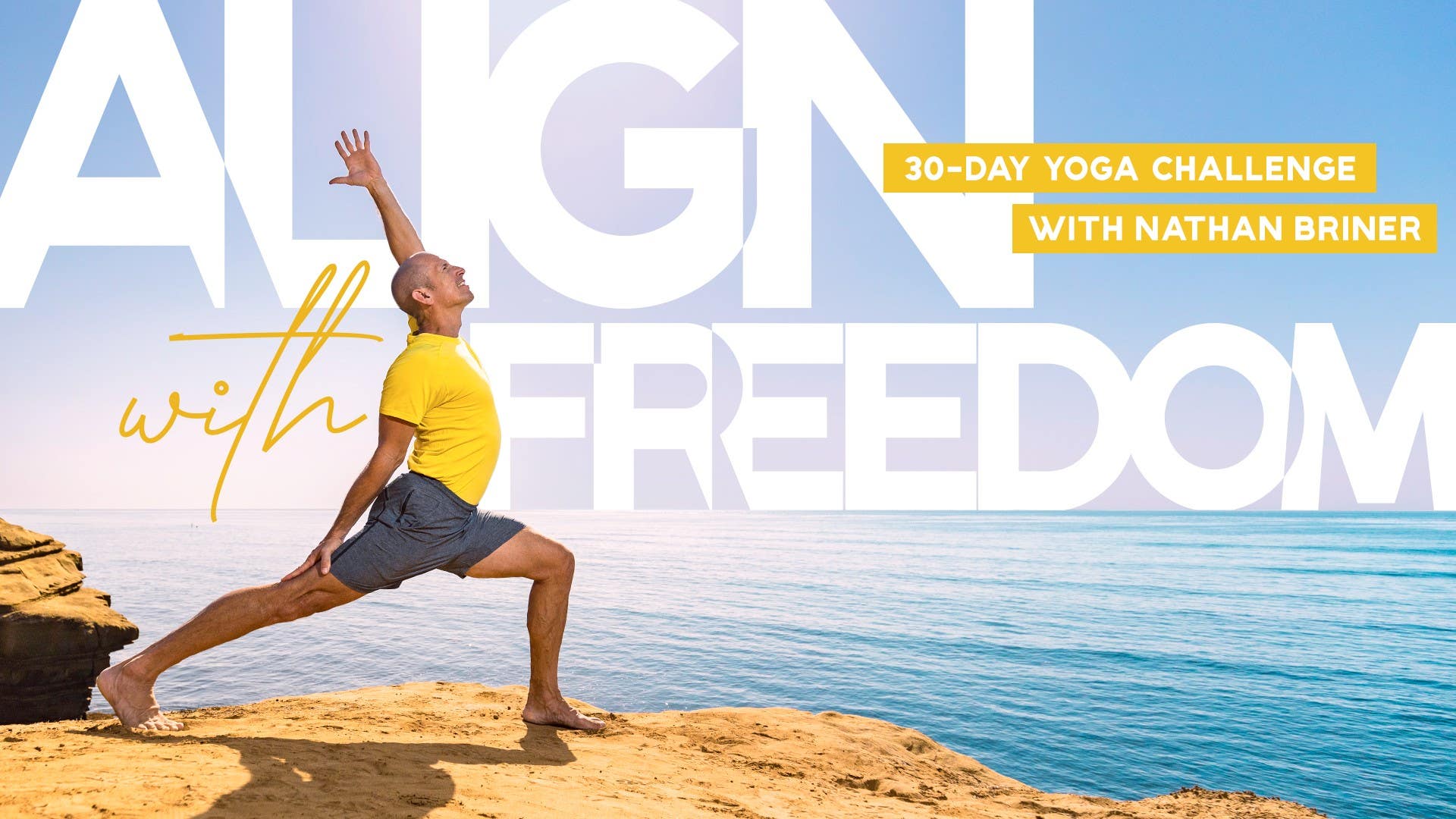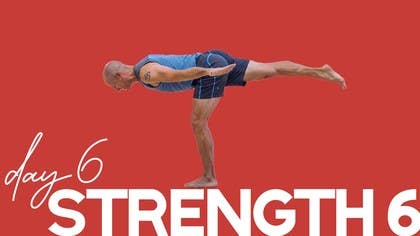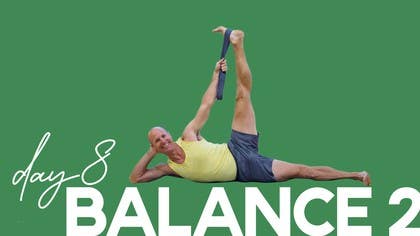Description
About This Video
Transcript
Read Full Transcript
All right, day six of our 30 day challenge and we are on the final day of our strength theme. This is a big day. We've got a warrior challenge that we're going to be doing together and I want to once again say congratulations for all the work you've been putting in and for being here again today. Just want to reiterate what we've been doing. We've been working on core strength.
We've been working a little on alignment and an essential element strength that is going to be so vital to our future themes to make sure that we can do the poses successfully. We're going to start out today in child's pose and take a little internal check in. Feet together, knees about the width of your mat and arms stretched out about the width of the shoulders. This is what I call an active child's pose. Like we've been working on in previous practices, sitting bones gently relaxed down, sacrum and lumbar relaxed down, and arms active, forehead down to the mat.
If you can't place the forehead down comfortably or if that bothers your shoulders, placing a block underneath your forehead and lifting up a little, we'll probably take care of that discomfort. By active arms, I am meaning arms that you would use for downward dog or plank pose. We want those arms active so that even though activity is happening, the neck can be soft, the spine can be long, the abdomen can be long and soft, and the hip joints are passive. A little internal scan through the body. Any adjustments you need to make or perhaps are there any props that would assist this pose for you?
How's your mind today? Racing, quiet? I'll ask you to put all of that on the side burner for now as we focus right here, right now and go for our warrior challenge. From here, please come up to all fours. We'll do a little cat and cow motion for the spine.
Always a great way to start and just get things moving. You've seen a number of different cat cow variations here. I'm now doing the side to side version. I want you to explore all the directions that your spine can go and see anywhere that needs just a little push into and opening up. Shoulders are moving.
Hips are moving. Tailbone going up, down, sideways. Take just a few more breaths to explore. And let's begin. Just walk the hands a little bit forward.
Curl the toes under, lift your knees. Little dog pedaling. One heel up at a time, opposite knee bent. Nice long deep breaths. Want to connect to that experience of breath, that easy flow.
And then high heel dog pose. Here leg muscles are firming. You may be feeling them from the previous practice. I understand completely. And then inhale.
Look forward. Hold the right foot between the hands and just practicing the lunge energy. That means thigh muscles lifting, knee cap strong, right hip lifting. And all of that to get a feeling as though the abdomen is lifted and supported and the spine is able to lengthen. Holding there, take some breath.
Set back dog pose. And second side. Lifting up. Back thigh, hip, abdomen supported. And stepping back.
Dog pose. And high heels. Stepping the right foot forward again. A little deeper lunge. Lower the back knee down.
Hands on the front knee. And let's drop the hips in. Remember we're not looking to get a lot of sensation out of the front of this hip or any pinching sensation out of the right hip, okay? Dropping in just to get a little space. Now ground down to the earth.
I've called it rooting down to the earth so you can get an uplifting feel in the spine. Back the hips out just a little. Left hand down. Right arm up. Right hand comes down.
Two hands to that front knee again. New style of pose. We're going to come around to grab the back foot. Now for some grabbing the back foot is a challenge. You might need a strap to hold on to that foot.
And we're leaning the hips forward. Definitely going to feel this in your back leg thigh, left thigh. Turn your chest open. And release. Let's step back through a dog pose.
High heels. Back and side to do left leg forward and drop the right knee down. Point the toes back. We'll bring the hands to the front knee and dropping in. Take some breaths.
Feel your body. Listen to it. Talk to you. Make any adjustments you need to make. And bring the hips out just from the pose a little.
Right hand down. Left arm up. Releasing. And then release the hand down. Going for our catch now.
So bring up the right leg. Reach back with the opposite hand to catch the foot. You can bring the right hand back down to help support the pose. Quad stretch. We're going to need this for our warrior challenge standing.
Turn the chest. And release. Hands on the ground. Step back to a plank pose. Big breath in.
Exhale to your version of Chaturanga. We're holding five. Navel up. Ribs up. Four.
Thighs up. Three. Two. Up dog. Again, thighs energized.
Strong arms. And pulling back for the dog pose. Getting all of our joints warmed up and ready. Then raise the heels. Look forward.
And our first jump together. Bend your knees a little. Look forward. Inhale. Exhale.
Hop to the front. Nice and easy. Feet together. Half Uttanasana. Forward fold.
Lengthen your spine. Take a few breaths here. And big breath in. Exhale. Let's soften into a forward fold.
Releasing your head. Release your neck. And then bend the knees. Lower your hips. Sweep the arms up over your head.
Be heels in this chair pose, Uttanasana. And come all the way out. Stand in mountain pose, Tadasana. Stretch down through the legs, that rooting action, until you feel the inner lift in your body. Feels like the inside of the body is lifting away from the floor.
That inner lift magically creates a quietening of the mind. As the mind begins to occupy that space. And then release. We'll step open wide to begin the standing warrior challenge. We'll start here wide legs, reconnect with the inner lift, pressing down to the legs.
Hunt for that feeling of lift through the upper body and stretch your arms. And we're looking for each limb to integrate with the next. Something we'll be diving much deeper into later in our challenge. But so that the arms are an expression of your inner lift. Right toes in, left leg out 90 degrees, first warrior, warrior two.
Some things to remember from our previous attempts at this pose. Back leg, groin muscles, lifting, folding deeply here at the left hip joint. Stretch your arms out from the center of your body, from the spine, and we're holding. That inner lift still palpable inside the body. Let's take that inner lift now to reverse warrior, right hand down to the thigh.
Lift your left arm up over your ear. Still the energy of the legs holding and supporting that inner lift, we're just expressing that lift in a different way. To warrior two, straighten your front leg, relax your arms, quick breather. Moving into crescent warrior, turn up off of your right heel. We now face directly over the left short end of the mat, arms up, and crescent warrior.
The work we've done in the lunge we're knowing here. I should mention if you cannot keep this back leg straight, if it keeps wanting to bend, it's likely you're too low, too deep in the pose, and the hip is preventing the energy of the leg. Exalted warrior, right hand to that back thigh. Turn the left palm again behind you, inner lift, lifting, helping us open. Spine feels spacious, not cramped, not pinched.
Keep working on that breath. I know it's a challenge here. To crescent, airplane arms, we're going to come forward, 45 with the trunk, arms alongside the hips, one, inhale, crescent. We've got three, exhale, two, preparing for warrior three, crescent, inhale. One more time, airplane arms, and a quick scoot forward with the back leg.
We're here, definitely feeling that left leg, lengthening the spine. We'll keep the standing leg bent, warrior three. Back leg very active, holding five, four, three, two, touchdown, a micro crescent, release your arms, turn to front, shake out that left leg. That is some serious strength we're working on there in the standing legs. Take a breather, work your way into an easy tadasana, feet a little apart, ragdoll.
Arms up, catch your elbows, hang down. Let the knees bend a little in this ragdoll. Take some breath, and you can start to feel in your own body. When that breathing starts to settle, that is really your cue that you're ready. Hands to knees, press the hands against the knees, lift your chest, let the blood come back down.
Ready? Here we go, wide legs. Find that earth, press down through the legs. Feel the muscles hug the bones. We need that connection, stretch out the arms, express your inner lift.
Left toes in, right leg out, warrior two, breath in, exhale, bend. Looking over your right middle finger. Arms alive in the arms, squeezing up against the arm bone, the humerus. Little adjustment for me to get a better position. Then left hand down, lift the right arm up over you, palm facing overhead.
Here's your reverse warrior. Remember, express your pose from that inner lift, not just as a matter of course, but because you feel that lift and you want to open deeper. To warrior two, release the arms, turn off of your left heel, well up off the ground there, arms up, and crescent warrior. Back leg strong. Why does it have to be strong?
Because it supports that inner lift all the way up through to the tops of the shoulders and the head. Exalted warrior. Left hand to the back thigh, turn your right hand to point behind you, expressing the inner lift in this way, to crescent warrior, 45 degrees arms, inhale and exhale, sweep, long spine. Inhale up. Remember, we've got three, exhale.
Here's two, inhale, last one, good, and then the little micro hop forward. Here's our warrior three, prep, keeping the standing leg bent, yes I know the heat you're feeling in that standing leg. Standing here, five, four, three, two, and touchdown for a micro crescent. And release, let that blood flow, relax the legs. Feet about hip width, we'll take ragdoll, hang down, capture your elbows, breathe, let that blood flow.
That is a strong warrior challenge. Wonderful to challenge the muscles of the legs, hips, mobility of the spine. Something to come back to again and again. Hands on knees. Press the hands against the knees, lift your chest.
That blood flow down, and then come up. Wide legs. We're going to get a little bit of relief from wide leg forward fold, root down through the floor, feel that leg energy, and fold forward. Hands to the floor. We've talked about in the past that if you have a lot of difficulty folding forward and you have quite a roundness in the back, blocks here would be a great idea for you.
Just holding here for a moment. Energy in the legs, not trying to turn the legs into concrete, but just supportive here as you lengthen the spine, allow the body to cool a little. You could choose to stay in this position if you're working on just lengthening the spine and mobilizing the hips. We can take it further by walking the hands in between the feet and releasing the trunk down. In theory, head to the floor.
You could also put a block in between your head and the floor to bridge that distance. Even soft, thighs firm. And then walk the hands forward, shorten your stance slightly. Left toes deeply in, right leg out, excuse me, right toes deeply in, left leg out, strongly out to the side, and this is half of Parsvottanasana, again, a cooling pose. Two straight legs.
And if you'd like to take it further, allow the trunk down. Walk the hands a little bit behind that front foot, legs well anchored into the floor, feeling very well connected to the earth, stability, firmness, so that the inner body can be calm and quiet, soft. Straightening the spine, look forward, turn to center. Inside left toes, deeply turned forward, around to the right side, right leg pointing straight ahead, starting with a straight portion of the spine and falling into the pose, releasing the body. Both legs straight, active, connecting well to the earth, creating firmness of foundation, so the inner body can be more pliable, quiet, and still, and the mind can rest in that stillness.
Going back to center, let's heel-toe out of our pose, heel-toe, heel-toe, heel-toe, heel-toe. Standing up, Tadasana. Let's do just a few moments of check-in here. Press down through the legs, look for that inner stillness and quiet. Let the arms be a little active extension of that inner stillness, inner lift.
Standing to the front edge of the mat, feet together, inhale, arms, exhale, forward fold. You choose. Bent legs are straight, whatever is best for your body at this point in this practice. Head down, neck soft, strong straight legs, and then hands on the floor, step back to a plank, hold, thighs up, hips up a little, navel strong, front ribs up into the body, away from the yoga mat, and then come down to your knees. We'll take a pause to set up the next pose.
This is a further expression of side angle. We'll start with a right hand on the ground, right leg long and straight. I'm going to press this bent leg into the floor for our side plank, supported side plank. Ready? Actively flexed right foot, lifting up.
One key note here, left heel should stay on the ground. Lift the hips a little higher, turn the chest, let's show off that top arm. Remember, it comes from that inner space. And then come down, we'll briefly move to the other side. Left hand on the floor, left leg straight, right leg bent, ready to support us.
Let's push down through the left arm, get ready for the support, and lifting up. Once again, right heel should be on the ground, drive down through that left arm to roll open the chest, from that inner space, project, lift that space out of your right arm. One, two, three, two, and one. Come down, let's do a little cat and cow. Release any tension that may have been gathered in the spine.
Lift up, exhale, release down, lift up, release down. And then an easy child's pose, just for a moment's rest. Couple more breaths, and then press yourself up to sitting. For this next pose, a wide legged seated twist, I'm gonna choose to sit on a blanket, gives me a little bit more height in the spine, one folded blanket, and legs out wide. This also allows me to reach a little bit more deeply over the legs.
Wide legs here, if you find your legs don't comfortably go down, more blanket support will help you. We'll start by turning left, right hand in between the two legs, left hand behind the body, and we're still using that lunge energy, back leg energy in these legs. This helps create that inner lift. We then lengthen the body over along the left leg, reach that right arm as you can towards that left foot. And here we're attempting to turn or roll the trunk right side down toward the yoga mat.
I'm taking my body into its depth, you go where you can go. Could be further, might not be as far, but please, do what only you can do. That's part of the challenge, is learning to understand you. And then coming up, let's do the second side. We'll take the left hand in between the legs, turning to the right, helping to start that revolution of the left side trunk, and then taking the body down over the right leg.
We stretch that left hand toward the right foot, revolving that left side trunk down. And then coming up, lean back, grab the inner knees, draw the legs in. You can come down off of your blanket, send that out of the way, lie down on your back. We'll be taking an active bridge to finish for today. Grab the sides of your mat, lift your hips, roll the shoulders under like we did in the previous practice.
This helps support your chest open. Soft neck, lifting the sacrum and tailbone, checking that the knees are about hip width, holding here for about a 10 count. And then release your shoulders, let your bottom down. Open the feet about the width of your mat, do a few side to side windshield wipers, allowing the open knee, in this case two knees right, the right knee is the opening knee or the downside knee. Let it fall all the way.
We'll do one more on each side after this. Last one. Let's make our way into Shavasana, gently lengthen the tailbone away from the low back. Low back is soft, still has its natural curve though. Lengthen out your legs, keep a little energy in the legs, tuck the shoulders slightly, and allow the energy of the legs to release, bring your attention inside.
You have accomplished so much through these past six practices. Using strength. If you felt these challenges, or at a very high level, keep coming back to them and you will watch that strength grow and grow. Let your breath settle down, and let your mind wander into that stillness with no agenda there. Let's make our way into Shavasana, gently lengthen the tailbone away from the low back.
If you would like to stay longer in Shavasana, please take the time to relax and let the body unwind. You've done a great job today. If you're ready to come out, rest your hands on your tummy, bend your knees one at a time. Turn off to your right side and just rest there for a few breaths and then to come out. Press your hands into the floor, find a comfortable seated position.
Well done today. Great job in tackling that warrior challenge. That is not an easy practice. All of the strength that we've been working on in these past six challenges can be done again and again so that we can build the strength that we need to go deeper into our yoga practice. So I recommend revisiting these practices over and over.
Our next area of challenge is going to be in balance, the theme of balancing, and we'll be dialing down the energy so not to fear. We'll be doing a little bit easier practices, almost a little restore in these practices, and challenging a whole new set of asana. Great job today. I look forward to seeing you in the theme of balance. Namaste.
Align with Freedom: 30-Day Yoga Challenge
Comments
You need to be a subscriber to post a comment.
Please Log In or Create an Account to start your free trial.



























